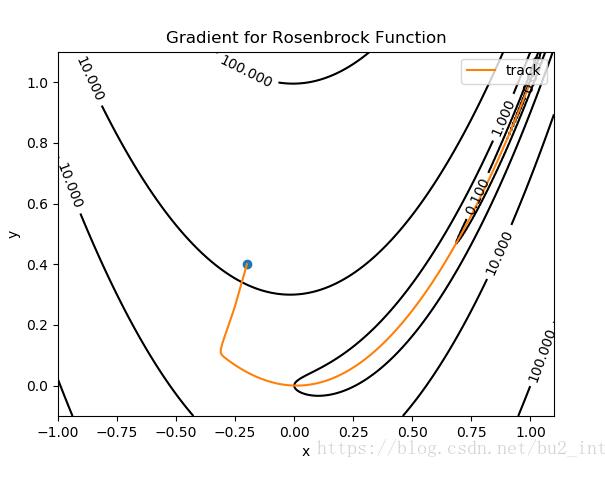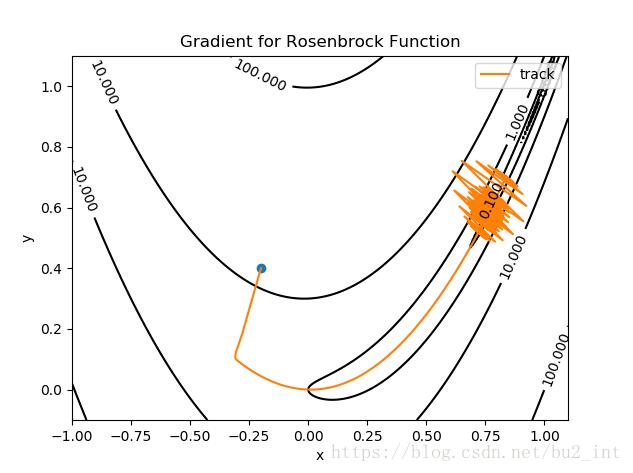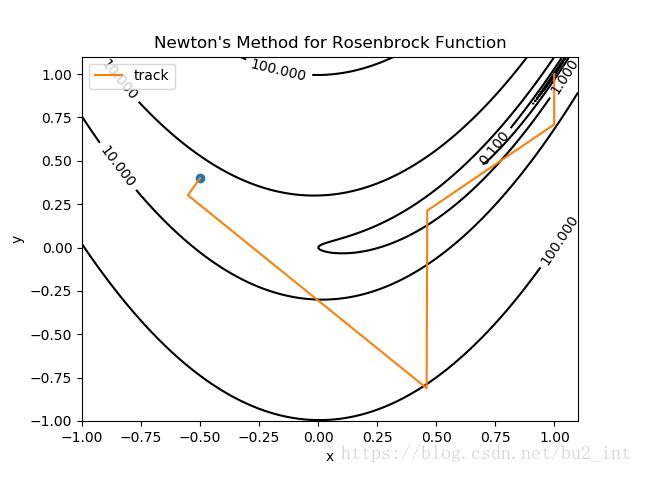python使用梯度下降和牛頓法尋找Rosenbrock函數(shù)最小值實(shí)例
Rosenbrock函數(shù)的定義如下:

其函數(shù)圖像如下:

我分別使用梯度下降法和牛頓法做了尋找Rosenbrock函數(shù)的實(shí)驗(yàn)。
梯度下降
梯度下降的更新公式:


圖中藍(lán)色的點(diǎn)為起點(diǎn),橙色的曲線(實(shí)際上是折線)是尋找最小值點(diǎn)的軌跡,終點(diǎn)(最小值點(diǎn))為 (1,1)(1,1)。
梯度下降用了約5000次才找到最小值點(diǎn)。
我選擇的迭代步長(zhǎng) α=0.002α=0.002,αα 沒(méi)有辦法取的太大,當(dāng)為0.003時(shí)就會(huì)發(fā)生振蕩:

牛頓法
牛頓法的更新公式:

Hessian矩陣中的每一個(gè)二階偏導(dǎo)我是用手算算出來(lái)的。

牛頓法只迭代了約5次就找到了函數(shù)的最小值點(diǎn)。
下面貼出兩個(gè)實(shí)驗(yàn)的代碼。
梯度下降:
import numpy as npimport matplotlib.pyplot as pltfrom matplotlib import tickerdef f(x, y): return (1 - x) ** 2 + 100 * (y - x * x) ** 2def H(x, y): return np.matrix([[1200 * x * x - 400 * y + 2, -400 * x], [-400 * x, 200]])def grad(x, y): return np.matrix([[2 * x - 2 + 400 * x * (x * x - y)], [200 * (y - x * x)]])def delta_grad(x, y): g = grad(x, y) alpha = 0.002 delta = alpha * g return delta# ----- 繪制等高線 -----# 數(shù)據(jù)數(shù)目n = 256# 定義x, yx = np.linspace(-1, 1.1, n)y = np.linspace(-0.1, 1.1, n)# 生成網(wǎng)格數(shù)據(jù)X, Y = np.meshgrid(x, y)plt.figure()# 填充等高線的顏色, 8是等高線分為幾部分plt.contourf(X, Y, f(X, Y), 5, alpha=0, cmap=plt.cm.hot)# 繪制等高線C = plt.contour(X, Y, f(X, Y), 8, locator=ticker.LogLocator(), colors=’black’, linewidth=0.01)# 繪制等高線數(shù)據(jù)plt.clabel(C, inline=True, fontsize=10)# ---------------------x = np.matrix([[-0.2], [0.4]])tol = 0.00001xv = [x[0, 0]]yv = [x[1, 0]]plt.plot(x[0, 0], x[1, 0], marker=’o’)for t in range(6000): delta = delta_grad(x[0, 0], x[1, 0]) if abs(delta[0, 0]) < tol and abs(delta[1, 0]) < tol: break x = x - delta xv.append(x[0, 0]) yv.append(x[1, 0])plt.plot(xv, yv, label=’track’)# plt.plot(xv, yv, label=’track’, marker=’o’)plt.xlabel(’x’)plt.ylabel(’y’)plt.title(’Gradient for Rosenbrock Function’)plt.legend()plt.show()
牛頓法:
import numpy as npimport matplotlib.pyplot as pltfrom matplotlib import tickerdef f(x, y): return (1 - x) ** 2 + 100 * (y - x * x) ** 2def H(x, y): return np.matrix([[1200 * x * x - 400 * y + 2, -400 * x], [-400 * x, 200]])def grad(x, y): return np.matrix([[2 * x - 2 + 400 * x * (x * x - y)], [200 * (y - x * x)]])def delta_newton(x, y): alpha = 1.0 delta = alpha * H(x, y).I * grad(x, y) return delta# ----- 繪制等高線 -----# 數(shù)據(jù)數(shù)目n = 256# 定義x, yx = np.linspace(-1, 1.1, n)y = np.linspace(-1, 1.1, n)# 生成網(wǎng)格數(shù)據(jù)X, Y = np.meshgrid(x, y)plt.figure()# 填充等高線的顏色, 8是等高線分為幾部分plt.contourf(X, Y, f(X, Y), 5, alpha=0, cmap=plt.cm.hot)# 繪制等高線C = plt.contour(X, Y, f(X, Y), 8, locator=ticker.LogLocator(), colors=’black’, linewidth=0.01)# 繪制等高線數(shù)據(jù)plt.clabel(C, inline=True, fontsize=10)# ---------------------x = np.matrix([[-0.3], [0.4]])tol = 0.00001xv = [x[0, 0]]yv = [x[1, 0]]plt.plot(x[0, 0], x[1, 0], marker=’o’)for t in range(100): delta = delta_newton(x[0, 0], x[1, 0]) if abs(delta[0, 0]) < tol and abs(delta[1, 0]) < tol: break x = x - delta xv.append(x[0, 0]) yv.append(x[1, 0])plt.plot(xv, yv, label=’track’)# plt.plot(xv, yv, label=’track’, marker=’o’)plt.xlabel(’x’)plt.ylabel(’y’)plt.title(’Newton’s Method for Rosenbrock Function’)plt.legend()plt.show()
以上這篇python使用梯度下降和牛頓法尋找Rosenbrock函數(shù)最小值實(shí)例就是小編分享給大家的全部?jī)?nèi)容了,希望能給大家一個(gè)參考,也希望大家多多支持好吧啦網(wǎng)。
相關(guān)文章:
1. ASP.NET MVC遍歷驗(yàn)證ModelState的錯(cuò)誤信息2. 將properties文件的配置設(shè)置為整個(gè)Web應(yīng)用的全局變量實(shí)現(xiàn)方法3. asp(vbs)Rs.Open和Conn.Execute的詳解和區(qū)別及&H0001的說(shuō)明4. jsp網(wǎng)頁(yè)實(shí)現(xiàn)貪吃蛇小游戲5. 用css截取字符的幾種方法詳解(css排版隱藏溢出文本)6. ASP 信息提示函數(shù)并作返回或者轉(zhuǎn)向7. asp中response.write("中文")或者js中文亂碼問(wèn)題8. PHP設(shè)計(jì)模式中工廠模式深入詳解9. CSS hack用法案例詳解10. ThinkPHP5實(shí)現(xiàn)JWT Token認(rèn)證的過(guò)程(親測(cè)可用)

 網(wǎng)公網(wǎng)安備
網(wǎng)公網(wǎng)安備